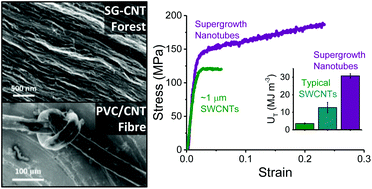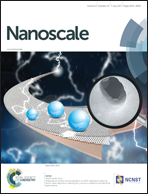Reductive dissolution of supergrowth carbon nanotubes for tougher nanocomposites by reactive coagulation spinning†
Abstract
Long single-walled carbon nanotubes, with lengths >10 μm, can be spontaneously dissolved by stirring in a sodium naphthalide N,N-dimethylacetamide solution, yielding solutions of individualised nanotubide ions at concentrations up to 0.74 mg mL−1. This process was directly compared to ultrasonication and found to be less damaging while maintaining greater intrinsic length, with increased individualisation, yield, and concentration. Nanotubide solutions were spun into fibres using a new reactive coagulation process, which covalently grafts a poly(vinyl chloride) matrix to the nanotubes directly at the point of fibre formation. The grafting process insulated the nanotubes electrically, significantly enhancing the dielectric constant to 340% of the bulk polymer. For comparison, samples were prepared using both Supergrowth nanotubes and conventional shorter commercial single-walled carbon nanotubes. The resulting nanocomposites showed similar, high loadings (ca. 20 wt%), but the fibres formed with Supergrowth nanotubes showed significantly greater failure strain (up to ∼25%), and hence more than double the toughness (30.8 MJ m−3), compared to composites containing typical ∼1 μm SWCNTs.



 Please wait while we load your content...
Please wait while we load your content...